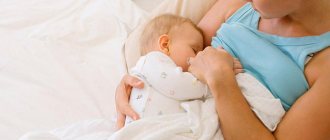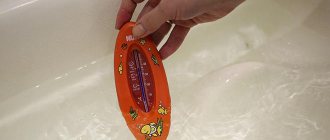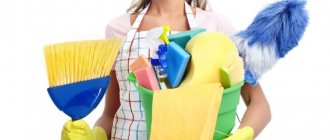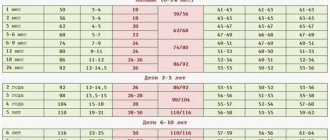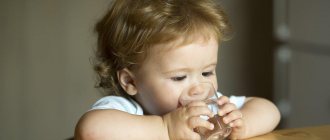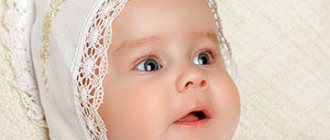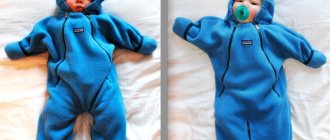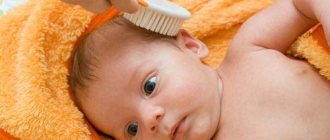Immediately after discharge, parents have many questions regarding the baby’s nutrition, organization of his sleep, and arranging a wardrobe for walks. At the same time, few people understand that it is important not only how a child spends time outside, but also what he does at home. Moreover, parents need not only to think about leisure time, but also to choose clothes for the newborn in which he will sleep and stay awake. In our article we will tell you how to properly dress your child at home in order to maintain his comfort and freedom of movement.
What should be the temperature of the house where the baby lives?
Before we talk about how to dress a newborn baby at home, it should be noted what the air temperature should be for the baby to feel comfortable. The optimal normal limits are within 20-24 degrees. If there are sides on the crib, then it is acceptable for the temperature to be 2-3 degrees lower than this indicator. But experienced pediatricians recommend completely abandoning the side and canopy, as they contribute to the disruption of air circulation and the accumulation of dust.
It is recommended to hang a thermometer in the room where the baby lives and always monitor its readings. If the baby is hot or cold, his health will worsen and insomnia will appear.
Features of thermoregulation in children
To understand how to dress a child, parents need to understand a little physiology. In newborns, the mechanisms of thermoregulation are not yet fully formed. If the baby was born prematurely or is not gaining weight well, it is even more difficult for him. In infants, the fat layer that protects against hypothermia is quite thin, and the sweat glands that remove heat are not yet functioning at full capacity. This is why it is easy for a child to overheat and freeze.
Overheating is especially dangerous, in which the body cannot give off heat, as a result of which liquid evaporates, moisture comes out, and metabolic functions are disrupted. This needs to be taken into account by grandparents, who always strive to dress the child as warmly as possible. If adults feel that the room is a little cool for them, perhaps this is the most comfortable temperature for the baby.
Based on this, before dressing your child at home for sleep or wakefulness, it is more correct to set the desired air temperature. A room thermometer will help you control it. It is advisable that the air temperature in the room in which the baby is located is between +18-22 degrees. However, here too it is better if it is lower, but not higher. In a hot room, the child becomes restless, is constantly capricious, has trouble falling asleep and often wakes up.
To maintain a comfortable air temperature in the children's room you need:
· use a thermometer,
monitor air humidity,
· arrange regular ventilation,
· install high-quality double-glazed windows,
· install winter-summer air conditioning.
In the crib in which the baby constantly sleeps, air should circulate freely. Therefore, it is better to abandon canopies and sides, which also collect a large amount of dust.
Material selection
How to properly dress a newborn? First of all, you need to pay attention to the material from which the clothes will be sewn or already made. It is very important that it is as soft and natural as possible. In this case, the baby will not experience an allergic reaction or irritation. Clothes may have zippers or fasteners, but it is very important that they are on hangers. It is recommended that the seams be directed to the front side. Only in this case will the newborn feel comfortable.
It is necessary to process the material correctly. For washing, you should only buy powder or gel that has a natural composition; the label should contain the inscription “from the first days of life” or “0+”. After washing, the laundry should be thoroughly dried and ironed on both sides.
How to dress properly at home
Every young mother should know how to dress a newborn at home. In the first month it is better to swaddle him in soft diapers. It is better to use material in calm and non-provocative tones. In the diaper, the baby will feel comfortable and protected, and the position of the arms and legs will be the same as it was in the womb. If the house is cool, then you need to use one warm or two thin diapers.
An older child, 2-6 months old, can wear a vest, rompers or one-piece suits. Additionally, it is recommended to wear gloves for newborns on the hands. If the air temperature in the room is from 20 to 25 degrees, then you can wear clothes made of thin cotton. If it is from 17 to 19 degrees, then it is recommended to put a fleece or flannel suit on your baby. It is very important to choose the right clothing size according to your baby’s height. He shouldn't feel embarrassed.
What to wear for your baby on the street
The most important piece of advice is that a newborn should be dressed appropriately for the weather. It would seem, what could be simpler? But there are some nuances.
Even young and “green” parents have probably heard more than once about such a phenomenon as special thermoregulation in infants. What is it and why is it remarkable?
Thermoregulation is the body’s ability to maintain a comfortable and safe body temperature for humans, regardless of environmental factors. Thanks to thermoregulation, we always have approximately the same temperature (illnesses and emergencies do not count): we do not heat up to 40 degrees in a sunny resort and do not freeze to minus 35 when we find ourselves in the cold on a frosty day.
In newborns, thermoregulation is still imperfect. But this does not mean that they are always cold and in any weather they need to be wrapped warmly. This means that infants react very sensitively to the ambient temperature: they quickly freeze in the cool and just as quickly overheat in the heat. That is, a newborn feels equally bad both in extreme heat and in cold.
Moreover, many doctors warn that overheating is more dangerous for a baby than cold: the baby may develop a fever and even experience heatstroke.
The opinion “it’s better to overheat than to freeze” is fundamentally wrong: moderation is important in everything.
In the first few months of a baby's life, you can dress a little warmer than yourself. There is a rule “plus one layer of clothing”: that is, if you yourself wear a T-shirt and jeans outside, you can add a light windbreaker on top and a cap for your baby. Clothes made from natural materials such as cotton are preferred.
In the summer heat, when the air temperature outside reaches +25-30 degrees, a newborn only needs to wear a light cotton bodysuit and a headdress, for example, a thin cap, to protect himself from overheating. In extreme heat above 30 degrees, if possible, it is better to avoid being in direct sunlight altogether: it will certainly be difficult for a newborn in such conditions, even if he is dressed lightly.
Sometimes representatives of the older generation advise young parents to put woolen socks on their babies in any weather, supposedly the newborn gets very cold, causing his feet to become very cold.
The baby’s feet do often become cool, but the point here is not that the baby is cold. Cool feet in a baby are his physiological norm. The baby's autonomic nervous system, which is responsible for thermoregulation, is not yet fully formed, and that is why the baby's feet often become cold.
There is no need to panic and wrap up your child, especially if he feels great: he eats well and sleeps peacefully. Therefore, in warm weather, wool socks are definitely unnecessary.
Maximum - thin cotton. Again: modern doctors urge parents to be prudent and appropriate - think for yourself whether the baby will be comfortable in woolen socks and a thick hat in thirty-degree heat.
According to Dr. Komarovsky, you need to pay attention not to whether the baby’s feet are cold or warm, but to the color of his skin. The pink baby is a happy baby who is not cold. Even if his feet are cool. If the newborn’s skin begins to turn blue, the child is freezing, take action.
How to dress properly at home at night
It is very important to know how to dress your baby at night at home. This determines how peacefully he will sleep and how he will feel after waking up. In addition, any involuntary movement may frighten him. The ideal sleepwear option is a sleeping bag or a warm diaper. A baby over 2 months old can wear a one-piece suit.
In addition to how to dress a newborn baby at home, he also needs to be wrapped in a thin blanket. Especially if he sleeps separately from his mother. He will be warmer under the blanket and will feel protected.
Does a baby need a cap and socks at home?
Some even put a cap on their child at home for fear of catching a cold in the head or ears. The chances of such an outcome are minimal, so there is no need to use a cap at home.
Reference! Children are much more difficult to tolerate overheating than cold, so there is no need to choose a hundred clothes.
You can refuse socks if the temperature at home is normal and the baby’s legs are covered, for example, with rompers or overalls.
If the feet are open, you can dress the baby in socks. It is normal for a baby to have slightly cool feet. This is an indicator of normal thermoregulation. Therefore, when feeling a child, you should not be afraid that he is cold.
It is necessary to constantly monitor the condition of the child and his environment. This will keep him healthy and not complicate the situation by overheating due to a large amount of clothing.
What should a guy wear to the club?
Gift from husband: 55,000 dresses
Do I need a hat?
Many mothers do not know whether a newborn baby needs a hat. In fact, according to pediatricians, it is necessary to wear a cap, but only in the first month of his life. At this moment, his thermoregulation has not yet improved, so he may freeze. Babies older than 1 month do not need to wear a cap at home, since by this time circulation will have already improved. It is recommended to wear a cap only after a bath and if the house is cool.
The requirements for a hat are the same as for other clothes; it must be made of natural and soft material. Ribbons should not be tied tightly so as not to cause discomfort to the baby. But if the house is hot, then you should not wear a cap, since overheating of the head can negatively affect the baby’s well-being.
How to dress a child after bathing?
- Immediately after taking water procedures, the baby should be wrapped in a towel. Special children's towels with hoods are convenient. After the baby has warmed up and you have blotted off all the moisture with a towel, you can change the baby
- As a rule, children are bathed before bed, so they wear pajamas. There are probably no special requirements for clothing after swimming.
- Special mention should be made of the hat. In the first months, putting a cap on your child for 20-30 minutes after bathing will not hurt. This time will be enough to dry the ears, as well as the hairs, which in some babies may be quite long from birth.
- For older babies (over 3 months), it will be enough to dry their hair with a towel.
Do you need socks?
If a hat is not always needed for a newborn, then socks are extremely necessary for a baby in two cases - if the air temperature at home is less than 18 degrees or he sleeps in clothes that do not include socks. Depending on the air temperature, socks can be thin or warm. It is very important that the baby’s feet do not freeze; this can lead not only to his discomfort, but also to illness.
Many pediatricians recommend giving the child daily air baths before meals or after waking up. This is a kind of hardening, which is necessary to strengthen the immune system, and the baby gradually begins to get used to his body and its movements. At the same time, the baby also needs to wear socks, since the heels, even with normal thermoregulation, can remain cool.
Wardrobe for babies
- Bodysuit with long and short sleeves (one or two pieces each);
- Romper and panties (minimum two pieces);
- T-shirts and T-shirts (two or three pieces each);
- Baby vests and/or children's shirts (two to four pieces);
- Socks are thin and warm (three to five pairs);
- Light blouses (two or three pieces);
- Warm sweaters (two or three pieces);
- Cotton caps (two or three pieces);
- Light hats (one or two pieces);
- Warm hats (one or two pieces);
- Light overalls made of cotton or flannel (one or two pieces);
- One insulated demi-season overalls;
- One warm winter overall with wool or fleece inside;
- Warm envelope and/or blanket;
- Booties and mittens (optional);
- Light cotton and warm flannel diapers.
How can you tell if your baby is hot or cold?
The infancy of a child is the most difficult for any parent. During this period, it is very difficult to determine what the baby wants and how he feels, since, apart from crying, he does not show any signs of illness. Therefore, in order to know how to dress a newborn at home, you need to understand whether he is hot or cold. This can be done as follows:
- You need to carefully touch his back under his clothes. Warm and slightly moist skin indicates that he is hot. In this case, he needs to be changed or unwrapped. But there is no need to completely undress, as a strong change in air temperature can lead to hypothermia and illness.
- You should look at the baby carefully. Red cheeks and a rapid pulse may indicate severe overheating. This is a very dangerous condition in which the baby’s body temperature can jump to critical levels. It is necessary to change the baby's clothes and give him some water.
- When choosing clothes for a newborn at home, many mothers touch his limbs to understand whether he is cold or not. This is not recommended, since even with normal thermoregulation, the palms and heels remain cool. An obvious sign of hypothermia is a cold nose or cheeks of the baby.
- It is also worth considering that all children are individual. Some people freeze or sweat at a certain temperature, while others feel comfortable; this largely depends on the age of the baby.
Experienced pediatricians recommend always looking at the baby's complexion to find out whether he is hot or cold. Red cheeks indicate overheating, and white cheeks indicate hypothermia. It is also worth considering that when a baby is cold, he becomes less mobile, thus saving energy.
The baby hiccups - is he cold?
If the room is too cool, the baby's muscles begin to tense and the stomach puts pressure on the diaphragm. As a result, the baby experiences an attack of hiccups. But that doesn't mean he's cold. Therefore, there is no point in wrapping him up warmer. Such a reaction of the body indicates that it can adapt to temperature changes. This is a sign of good baby development.
Hiccups can also occur for other reasons:
- Excessive feeding. If you overfeed a newborn with formula, he may start to hiccup.
- Decreased body temperature.
- Swallowing air.
If a child eats more formula than he should, his stomach begins to quickly stretch and fill. As a result, diaphragm spasms appear, causing hiccups.
When breastfeeding, this situation can be avoided. This is due to the easy absorption of mother's milk. Thanks to this, there is no strong pressure on the stomach, which has not yet fully strengthened.
It is important to strictly adhere to the dosage when feeding with formula. Do not neglect the rules indicated on the jar.
When a mother breastfeeds, the baby may latch on poorly, causing him to swallow air along with the milk, which will lead to hiccups. It is necessary to correct the breast latch and help the child do it correctly. Then he will not hiccup and will gain weight in a timely manner.
Rules for using diapers
Another important question, besides how to dress a newborn at home, is how to properly use diapers. For a newly born baby, they are an integral part of the wardrobe.
Before changing the diaper, it is very important to wash the baby or wipe the skin with a damp cloth, treat it with powder or cream. Only after this you need to put on a diaper that fits him in size, carefully straightening it from the front and back.
A wardrobe for a baby should correspond to the temperature conditions at home and be comfortable for him. Only in this case will he sleep well, feel great and please his parents in a good mood.
